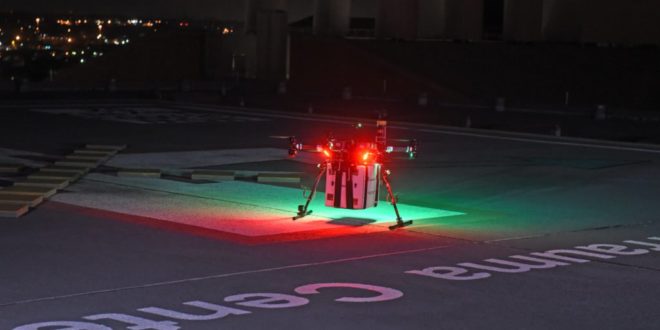In a world-first flight and a significant step for human medicine, a University of Maryland drone has delivered a donor kidney to surgeons at the University of Maryland Medical Center, before being successfully transplanted into a patient with kidney failure.
It’s an exciting development in the use of drones to support emergency services and medical deliveries and demonstrates how, in future, organ delivery by drone could be faster, safer, and just as reliable as traditional transport methods.
The flight follows on from extensive tests the University of Maryland has undertaken in recent times. You can read more about those here: Drones Can Do Liver: Maryland Tests Show Potential of Unmanned Organ Transport.
Innovation and collaboration
The flight was a collaboration between transplant physicians and researchers at the University of Maryland School of Medicine in Baltimore; aviation and engineering experts at the University of Maryland, the University of Maryland Medical Center and partners at the Living Legacy Foundation of Maryland.
“This major advance in human medicine and transplantation exemplifies two key components of our mission: innovation and collaboration,” said E. Albert Reece, MD, PhD, MBA, Executive Vice President for Medical Affairs, UM Baltimore, and the John Z. and Akiko K. Bowers Distinguished Professor and Dean, University of Maryland School of Medicine.
“Innovation is at the heart of our focus on accelerating the pace and scope of discovery, where research can rapidly transform medicine. At the same time, collaboration is the key to our success in providing discovery-based medicine – both in conducting research and in delivering the highest quality patient care.”
A drone carrying a donated kidney, proving the potential of emergency organ delivery. Image Credit: Mark Teske/University of Maryland School of Medicine
Designing a drone to carry organs
Maryland faculty and researchers have suggested that the first organ transport by drone “blazes a trail for the use of UAS to expand access to donated organs, improving outcomes for more people in need of organ transplants.”
“As a result of the outstanding collaboration among surgeons, engineers, the Federal Aviation Administration (FAA), organ procurement specialists, pilots, nurses, and, ultimately, the patient, we were able to make a pioneering breakthrough in transplantation,” said Joseph Scalea, MD, assistant professor of surgery at UMSOM, project lead, and one of the surgeons who performed the transplant at UMMC.
There were a number of technological feats at the foundation of the successful organ delivery.
Read more: Drone Delivery Heroes Zipline Launch World’s Largest Vaccine Delivery Network in Ghana
They included specially designed, high-tech apparatus for maintaining and monitoring the human organ, a custom eight-rotor drone, multiple powertrains to ensure reliable performance, a wireless mesh network to control the drone, monitor the aircraft’s status, and provide communications for ground crews at multiple locations… and new aircraft operating systems ensure best practices, in terms of both UAS and organ transport standards.
“We had to create a new system that was still within the regulatory structure of the FAA, but also capable of carrying the additional weight of the organ, cameras, and organ tracking, communications, and safety systems over an urban, densely populated area—for a longer distance and with more endurance,” said Matthew Scassero, MPA, director of UMD’s UAS Test Site, part of A. James Clark School of Engineering.
“We built in a lot of redundancies, because we want to do everything possible to protect the payload,” said Anthony Pucciarella, director of operations at the UMD UAS Test Site. These safeguards included backup propellers and motors, dual batteries, a backup power distribution board, and a parachute recovery system (in case the entire aircraft fails).
“This history-making flight not only represents a breakthrough from a technological point of view, but provides an exemplary demonstration of how engineering expertise and ingenuity ultimately serve human needs – in this case, the need to improve the reliability and efficiency of organ delivery to hospitals conducting transplant surgery,” said Darryll J. Pines, Ph.D., dean of the A. James Clark School of Engineering and Nariman Farvardin Professor of Aerospace Engineering.
“As astonishing as this breakthrough is from a purely engineering point of view, there’s a larger purpose at stake. It’s ultimately not about the technology; it’s about enhancing human life.”
A number of medical technology companies came together to design and develop the Human Organ Monitoring and Quality Assurance Apparatus for Long-Distance Travel (HOMAL). The system measures and maintains temperature, barometric pressure, altitude, vibration, and GPS location during transportation. The data is sent to the smartphones of transplant personnel.
Read more: Matternet Station Enables Medical Drone Delivery in Switzerland
Is this the future of organ transport?
Getting organs from one location to another without compromising its viability is, in many ways, just as complicated as the transplant itself.
Often, organs are transported using expensive chartered flights or rely on commercial flights. Both of these methods can result in delays that put the organ beyond use.
According to the United Network for Organ Sharing, which manages the organ transplant system in the United States, in 2018 there were nearly 114,000 people on waiting lists for an organ transplant; about 1.5 percent of deceased donor organ shipments did not make it to the intended destination; and nearly four percent of organ shipments had an unanticipated delay of two or more hours.
“There remains a woeful disparity between the number of recipients on the organ transplant waiting list and the total number of transplantable organs. This new technology has the potential to help widen the donor organ pool and access to transplantation,” said Scalea. “Delivering an organ from a donor to a patient is a sacred duty with many moving parts. It is critical that we find ways of doing this better.”
Drone delivery could well be part of the solution, at least for the transport of organs across relatively short distances.
“The University of Maryland UAS project is incredibly important,” said Charlie Alexander, Chief Executive Officer of project collaborator the LLF. “If we can prove that this works, then we can look at much greater distances of unmanned organ transport. This would minimize the need for multiple pilots and flight time and address safety issues we have in our field.”
Malek Murison is a freelance writer and editor with a passion for tech trends and innovation. He handles product reviews, major releases and keeps an eye on the enthusiast market for DroneLife.
Email Malek
Twitter:@malekmurison
Subscribe to DroneLife here.
https://dronelife.com/2019/05/01/university-of-maryland-drone-delivers-kidney-for-successful-transplant/
 Unmanned Aerial Vehicle The latest drone news
Unmanned Aerial Vehicle The latest drone news


